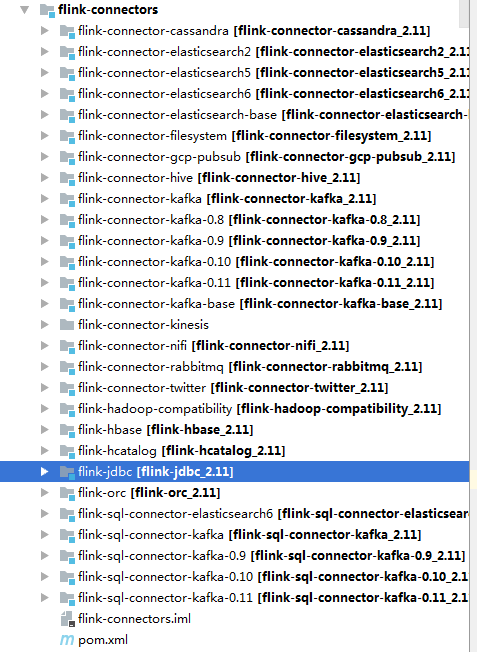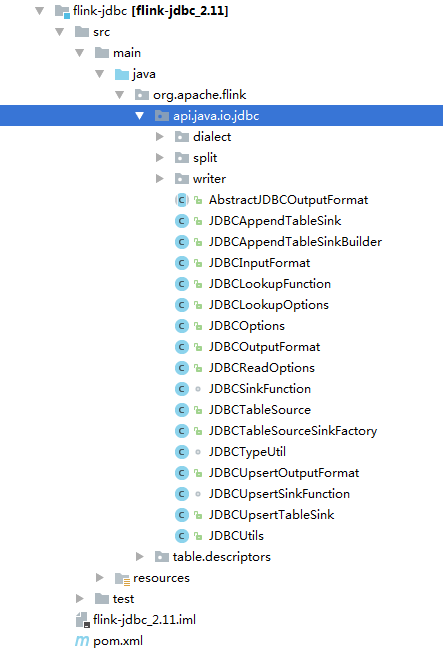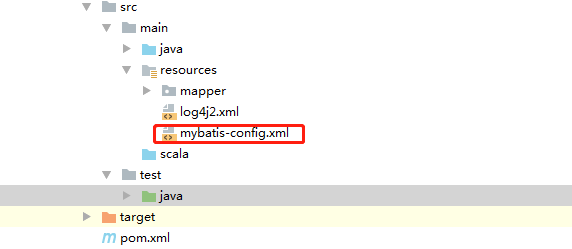flink 流式處理中如何整合mybatis框架
flink 中自身雖然實現了大量的connectors,如下圖所示,也實現了jdbc的connector,可以通過jdbc 去操作資料庫,但是flink-jdbc包中對資料庫的操作是以ROW來操作並且對資料庫事務的控制比較死板,有時候操作關係型資料庫我們會非常懷念在java web應用開發中的非常優秀的mybatis框架,那麼其實flink中是可以自己整合mybatis進來的。 我們這裡以flink 1.9版本為例來進行整合。

如下圖為flink內部自帶的flink-jdbc:

建立一個flink的流式處理專案,引入flink的maven依賴和mybatis依賴(注意這裡引入的是非spring版本,也就是mybatis的單機版):
<properties>
<flink.version>1.9.0</flink.version>
</properties>
<!-- https://mvnrepository.com/artifact/org.mybatis/mybatis -->
<dependency>
<groupId>org.mybatis</groupId>
<artifactId>mybatis</artifactId>
<version>3.5.2</version>
</dependency>
<!-- flink java 包 -->
<dependency>
<groupId>org.apache.flink</groupId>
<artifactId>flink-streaming-java_2.11</artifactId>
<version>${flink.version}</version>
</dependency>maven依賴引入以後,那麼需要在resources下面定義mybatis-config.xml 配置:

mybatis-config.xml 需要定義如下配置:
<?xml version="1.0" encoding="UTF-8"?>
<!DOCTYPE configuration PUBLIC "-//mybatis.org//DTD Config 3.0//EN"
"http://mybatis.org/dtd/mybatis-3-config.dtd">
<configuration>
<typeAliases>
<typeAlias alias="BankBillPublic" type="xxxx.xx.xx.BankBillPublic" />
</typeAliases>
<environments default="development">
<environment id="development">
<transactionManager type="JDBC" />
<dataSource type="POOLED">
<property name="driver" value="com.mysql.jdbc.Driver" />
<property name="url" value="jdbc:mysql://xx.xx.xx.xx:3306/hue?characterEncoding=UTF-8&zeroDateTimeBehavior=convertToNull&allowMultiQueries=true&autoReconnect=true" />
<property name="username" value="xxxx" />
<property name="password" value="xxxx*123%" />
</dataSource>
</environment>
</environments>
<mappers>
<mapper resource="mapper/xxxxxMapper.xml" />
</mappers>
</configuration>typeAlias 標籤中為自定義的資料型別,然後在xxxxxMapper.xml 中parameterType或者resultType就可以直接用這種定義的資料型別。
<mappers> 下面為定義的mybatis 的xxxxxMapper檔案。裡面放置的都是sql語句。
xxxxxMapper.xml 中的sql示例:
<?xml version="1.0" encoding="UTF-8"?>
<!DOCTYPE mapper PUBLIC "-//mybatis.org//DTD Mapper 3.0//EN"
"http://mybatis.org/dtd/mybatis-3-mapper.dtd">
<mapper namespace="xx.xx.bigdata.flink.xx.xx.mapper.UserRelaInfoMapper">
<!--查詢關鍵字匹配 -->
<select id="queryUserRelaInfo" parameterType="String" resultType="UserRelaInfo">
SELECT id AS id,
USER_NAME AS userName,
APPL_IDCARD AS applIdCard,
PEER_USER AS peerUser,
RELA_TYPE AS relaType,
CREATE_USER AS createUser,
CREATE_TIME AS createTime
FROM USER_RELA_INFO
<where>
<if test="applIdCard != null">
APPL_IDCARD=#{applIdCard}
</if>
<if test="peerUser != null">
AND PEER_USER=#{peerUser}
</if>
</where>
</select>
</mapper>
定義Mapper,一般可以定義一個interface ,和xxxxxMapper.xml中的namespace保持一致
注意傳入的引數一般加上@Param 註解,傳入的引數和xxxxxMapper.xml中需要的引數保持一致
public interface UserRelaInfoMapper {
List<UserRelaInfo> queryUserRelaInfo(@Param("applIdCard")String applIdCard,@Param("peerUser") String peerUser);
}
定義SessionFactory工廠(單例模式):
/**
*
* sqlsession factory 單例 事務設定為手動提交
*/
public class MybatisSessionFactory {
private static final Logger LOG = LoggerFactory.getLogger(MybatisSessionFactory.class);
private static SqlSessionFactory sqlSessionFactory;
private MybatisSessionFactory(){
super();
}
public synchronized static SqlSessionFactory getSqlSessionFactory(){
if(null==sqlSessionFactory){
InputStream inputStream=null;
try{
inputStream = MybatisSessionFactory.class.getClassLoader().getResourceAsStream("mybatis-config.xml");
sqlSessionFactory = new SqlSessionFactoryBuilder().build(inputStream);
}
catch (Exception e){
LOG.error("create MybatisSessionFactory read mybatis-config.xml cause Exception",e);
}
if(null!=sqlSessionFactory){
LOG.info("get Mybatis sqlsession sucessed....");
}
else {
LOG.info("get Mybatis sqlsession failed....");
}
}
return sqlSessionFactory;
}
}
使用mybatis 對資料庫進行操作:
SqlSession sqlSession = MybatisSessionFactory.getSqlSessionFactory().openSession();
UserRelaInfoMapper userRelaInfoMapper = sqlSession.getMapper(UserRelaInfoMapper .class);
//呼叫對應的方法
userRelaInfoMapper.xxxx();
//提交事務
sqlSession.commit();
//回滾事務,一般可以捕獲異常,在發生Exception的時候,事務進行回滾
sqlSession.rollback();
這裡以mysql為示例,寫一個flink下mysql的sink示例,可以自己來靈活控制事務的提交:
public class MysqlSinkFunction<IN> extends RichSinkFunction {
private static final Logger LOG = LoggerFactory.getLogger(MysqlSinkFunction.class);
@Override
public void invoke(Object value, Context context) throws Exception{
SqlSession sqlSession = MybatisSessionFactory.getSqlSessionFactory().openSession();
try{
//插入
LOG.info("MysqlSinkFunction start to do insert data...");
xxx.xxx();
//更新
LOG.info("MysqlSinkFunction start to do update data...");
xxx.xxx();
//刪除
LOG.info("MysqlSinkFunction start to do delete data...");
xxx.xxx();
sqlSession.commit();
LOG.info("MysqlSinkFunction commit transaction success...");
}
catch (Throwable e){
sqlSession.rollback();
LOG.error("MysqlSinkFunction cause Exception,sqlSession transaction rollback...",e);
}
}
}
相信您如果以前在spring中用過mybatis的話,對上面的這些操作一定不會陌生。由此你也可以發現,在大資料中可以完美的整合mybatis,這樣可以發揮mybatis框架對資料庫操作的優勢,使用起來也非常簡單方便。
一旦集成了mybaitis後,在flink中就可以方便的對各種各樣的關係型資料庫進行操作了。
本文作者張永清,轉載請註明出處:flink 流式處理中如何整合mybatis框
